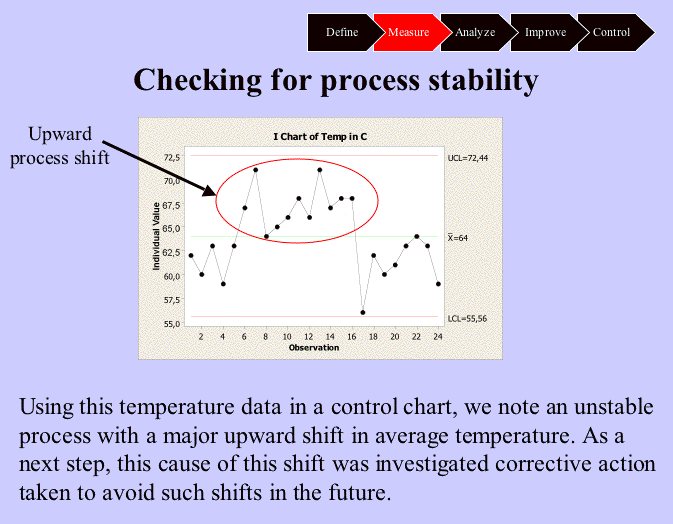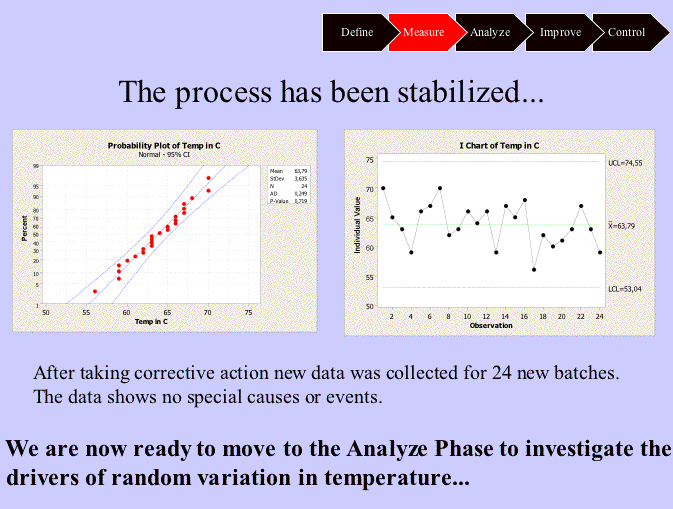
Six Sigma’s step-by-step approach to problem solving has benefited greatly from the development of a common toolkit, project framework and terminology. That commonality, to a large extent, has made Six Sigma a business phenomenon transcending corporate and national boundaries. However, one broadly implemented element of Six Sigma project management that is often underestimated is the project storyboard.
The storyboard is generally understood as a document, in electronic form, which summarizes project progress and demonstrates what tools have been applied in what sequence in the course of defining the process problem and then analyzing and resolving it. It is normally expected that this storyboard be kept up-to-date with the latest developments as a project progresses.
Unfortunately, storyboards are often thought of as a bureaucratic and perfunctory exercise and left to the last minute as a way to leave behind at least some minimal written evidence of the project’s history and achievements. As important as storyboards are as a documentation tool, however, they go well beyond the mere summarizing of results. They actually contribute to the success of both individual projects and that of the Six Sigma program as a whole.
Storyboards Reflect Logic and Flow of DMAIC
The basic format of a typical storyboard is based on DMAIC, the project structure and approach to problem solving used throughout the Six Sigma world. The first three phases of DMAIC (Define, Measure, Analyze) define the problem and help answer questions about the current process state and the root causes of unsatisfactory process outcomes. The remaining steps (Improve, Control) focus on changing the current process to meet improvement goals.
While some organizations adapt DMAIC to their own needs or tastes, renaming or combining phases for example, the essential content and logical flow of the process remain and are universally recognized as a key factor for project success. Storyboards reflect this logic by being divided into five key chapters, with each page clearly indicating what phase it is in.
Although the emphasis on storyboards here is as presentation tools, the key is that the storyboard does what the name implies, i.e., tells a story as if it were posted on a board for others to absorb on their own. That means the messages in it should be comprehensible even without the presence of the person who wrote it. It is helpful for this purpose that each page is readily understood in the context of both the preceding page and the pages that follow. Since tools are used in a certain sequence to answers questions and build arguments, they should be presented as such. In short: If a person can grasp the logic of a storyboard, they have grasped the logic of the Six Sigma way of improving and managing business processes.
For example, say a project team is in the Measure phase and collected data on temperatures of a liquid at a certain point in a chemical process. After first confirming if the data was normally distributed, a control chart showed that for the period in which data was collected the process not only showed natural, random variation, but also contained assignable (special cause) variation in the form of a process shift. The storyboard captures the flow of the investigation and tool application at this point in the project in a way that is informative and useful for a variety of situations.
Here are four example slides:




Some organizations choose to formalize the storyboard format by including a standard slide structure, corporate or Six Sigma program logos, etc. Some go a step further by requiring the use of templates for the key tools to create a stricter consistency in the look and style of individual projects storyboards. Others prefer to let project leaders use their own creativity to produce effective storyboards.
The basic structure illustrated in the example is valid for all storyboard applications outlined below, although the content and level of detail may vary according to need.
Storyboards as a Coaching Tool
The most successful Six Sigma initiatives provide trainees with individual coaching to help them complete the process improvement projects they are leading as part of their training. The DMAIC methodology is the basic framework for individual projects. However, it is one thing to explain this in a classroom, it is potentially another to make sure DMAIC and the tools it encompasses are applied consistently and correctly.
This is where project coaching comes in. Typically conducted by the trainers themselves between training weeks and continuing on until project completion, coaching consists of personal meetings with the trainees/project leaders to help them apply classroom learning to their specific project situations. The coach is there to reinforce what minimum deliverables are expected in each DMAIC phase and to help anticipate what additional tools will be needed in a particular project situation. Without this support, Black Belts in training run the serious risk of internalizing misunderstandings about tool usage that in turn can lead to bad habits such as collecting poor quality data and compromising the validity of analysis results by ignoring key assumptions about statistical tools.
The storyboard can function as the focal point of a coaching session. At the beginning of each session the project leader uses it to display what has been done since the last meeting, taking the coach through the activities and showing the results of the tools employed. By doing so, he or she is challenged to demonstrate knowledge of DMAIC and individual tools. At the same time, the coach can easily see into the project leader’s thinking and point out where the gaps are.
The storyboard also can be used during coaching to capture guidance on next steps. For example, the coach can draft several new pages in the document (usually simple page headings indicating the type and sequence of appropriate tools are enough) and ask the project leader to fill in these pages with actual results in the form of graphs, charts, test results, summaries, etc. as the project moves forward. In this way, the storyboard also becomes a planning tool or “to-do” list of next steps agreed upon by both coach and project leader for review in the next coaching session. This not only supports the learning process but also allows project leaders to concentrate on important tasks and avoid time-consuming dead ends.
Precisely because the storyboard’s structure reflects the DMAIC project flow, they help project leaders and the team as a whole stay focused on the necessary activities at any given time point. Typical pitfalls can therefore be avoided such as discussing solutions prematurely (before the root causes of the problem have been examined) and falling into the trap of “scope-creep,” in which more and more goals are added to the project, potentially leading to unachievable expectations beyond the original intentions.
A Project Tracking and Reporting Tool
Business leaders have one thing in mind when they plan the introduction of Six Sigma – improving business results.
Considering the costs of training project leaders and running projects, it is clearly in the best interests of the organization to encourage success. When projects fail to deliver, they can lead to scepticism about the validity of Six Sigma, cause the new program to first falter, then eventually run out of steam as people remain unconvinced of its potential to improve the business.
However, when business leaders and project sponsors are actively involved and are kept informed about progress, the will to stay on track remains strong. Periodical project reviews (e.g., once per month) in the form of storyboard presentations allow key stakeholders to keep abreast of recent developments about the real root causes of process problems. Of course, it will not be necessary to present the same level of detail to an executive audience as to the project coach. But it is a simple enough task to create a subset of the storyboard slides that will be appropriately informative.
Project leaders can be kept on their toes when they know others are waiting at regular intervals to see their work. And since the storyboard is already there for coaching purposes, generating management presentations and executive summaries from it requires little extra effort.
A Deliverable for Black Belt Certification
It is a basic assumption in business that projects should be documented. However, when this documentation is expected to be not only a record of activities but also a display of the project leader’s skills, it takes on a whole new dimension.
When project leaders are preparing for their Black Belt certification, they are required to demonstrate their knowledge and skills in conducting process improvement projects. What better way to present this knowledge than in a clearly structured project storyboard that not only captures results but also clearly reveals the extent and accuracy of the candidate’s understanding and learning. Again: If a person can grasp the logic of a storyboard, they have grasped the logic of DMAIC (and are demonstrating this fact to others).
A Tool for Change Management
Six Sigma in its complete sense is about changing the way processes, and by extension, the business is managed. More easily said than done.
Part of managing such change, in both the short and the long term, is to keep people informed about what is happening around them. Members of the organization need to know what the Six Sigma program is all about and how individual projects are going to affect them.
Just as at the management level, storyboards (or suitable subsets thereof) can be used to make simple presentations about project activities, to indicate where the real root causes of problems lie, to stress why it is important that they be fixed, and to communicate what the solutions will look like.
People will learn that Six Sigma is not about finding someone to blame for poor process performance, but rather to understand the faults of the system itself and eliminate problems so that the business, and the organization as a whole, will prosper. Easily understood storyboard presentations not only clarify the issues, they pave the way for active dialog around them. When people participate in change, they are more likely to lend their support to achieve it.
A Knowledge Transfer and Education Tool
A Six Sigma program should not be implemented just for the sake of conducting process improvement projects. The longer-term goal should be to establish a process-oriented system that rigorously manages towards specified process outcomes. To attain this goal, many key understandings about process measurements, data collection and analysis will eventually have to be passed on by the trainees to others in the organization.
As a minimum, project leaders will make regular use of their storyboards in educating their team members on how tools work together to answer questions about the process. However, managers, sponsors and business leaders also will benefit from continued learning as they observe results and participate in discussions during project reviews that are based on these same storyboards.
The more members of an organization are exposed to the logic and flow of DMAIC through project storyboards, the sooner everybody becomes comfortable with the issues and the language of Six Sigma. As more interest is stimulated and more people get involved, the organization can move toward self-sufficiency in training and project coaching. By doing so, a solid foundation for the long-term success of the Six Sigma program is established.
Project storyboards are not just a nice-to-have collection of slides for getting project documentation over and done with. They are a central tool for learning, planning, reporting and communicating, and they support the transfer of knowledge from those who receive formal Six Sigma training to the rest of the organization. No Six Sigma program with long-term plans for successful change can afford to underestimate their importance.